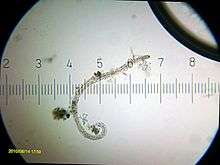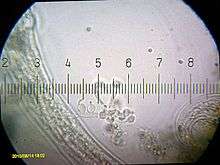Nematophagous fungus

A dead nematode with Harposporium anguillulae growing out of it. Numbered ticks are 122 µm apart.

A closer look at some of the Harposporium anguillulae in the previous image. Numbered ticks are 20 µm apart.

A fungus of the genus Arthrobotrys, showing adhesive nets which it uses to trap nematodes. Numbered ticks are 122 µm apart.
Nematophagous fungi are carnivorous fungi specialized in trapping and digesting nematodes. Around 160 species are known. There exist both species that live inside the nematodes from the beginning and others that catch them mostly with glue traps or in rings, some of which constrict on contact. Some species possess both types of traps. Another technique is to stun the nematodes using toxins, which is a method employed by Coprinus comatus, Stropharia rugosoannulata, and the family Pleurotaceae.[1]
Nematophagous fungus can be useful in controlling nematodes. Purpureocillium for example can be used as a bio-nematicide.
References
- ↑ Thorn, R. Greg; Moncalvo, Jean-Marc; Reddy, C. A.; Vilgalys, Rytas (Mar–Apr 2000). "Phylogenetic Analyses and the Distribution of Nematophagy Support a Monophyletic Pleurotaceae within the Polyphyletic Pleurotoid-Lentinoid Fungi". Mycologia. 92 (2): 241–252. doi:10.2307/3761557. JSTOR 3761557.
External links
This article is issued from Wikipedia - version of the 11/17/2015. The text is available under the Creative Commons Attribution/Share Alike but additional terms may apply for the media files.